Top 6 ResMed CPAP Masks for Side Sleepers (2025 Guide)
If you’re a side sleeper struggling with CPAP therapy, there’s a reason why. Over 60% of American adults prefer side sleeping, yet most CPAP masks weren’t designed for lateral sleep positions—causing painful pressure points, annoying air leaks, and frequent therapy disruptions.
ResMed has targeted these specific side sleeping problems with CPAP mask designs which we’ll cover in this article. Let’s take a look at how these masks can help solve the issues that keep side sleepers from getting a good night’s sleep.
New Release: ResMed just launched the AirFit F40, their most compact full-face mask yet. With innovative AdaptiSeal cushion technology and a 98% fit rate, it’s designed specifically to maintain seal integrity during side sleeping—even at higher pressures. Check out the AirFit F40 here to see if it’s right for you.
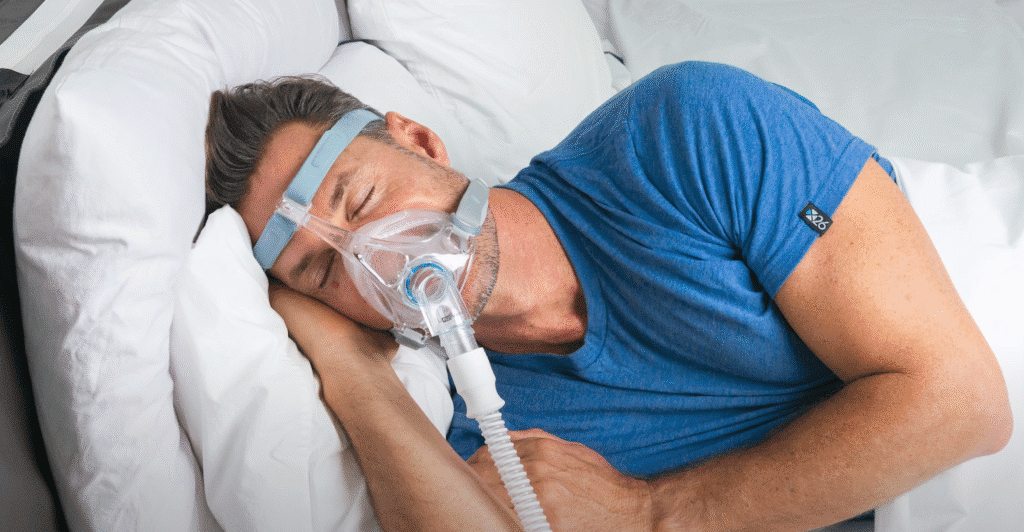
Disclosure: This post contains affiliate links.
Why Standard CPAP Masks Fail Side Sleepers
Traditional CPAP masks create problems for lateral sleep positions. Within minutes of lying down, pillow pressure pushes against bulky mask frames, breaking the therapeutic seal and triggering disruptive alarms that wake both you and your partner.
Rigid mask designs dig into facial tissue throughout the night, leaving morning marks that can persist for hours. The restricted movement prevents natural sleep position changes, creating muscle tension and sleep fragmentation.
When masks leak during side sleeping, most people tighten the headgear straps, which makes leaks worse while creating more pressure points. This cycle drives many patients away from consistent CPAP therapy.
Finding a CPAP mask that works with your preferred sleep position is crucial for long-term therapy success. When you’re comfortable sleeping on your side, you’re more likely to use your CPAP consistently and get the restorative sleep you need.
Top 6 ResMed Masks for Comfortable Side Sleeping
| Mask Model | Type | Ideal For | Key Comfort Features | Pressure Range | Best For |
|---|---|---|---|---|---|
| AirFit P10 | Nasal Pillows | Best Value | Ultra-light design, 17″ flexi-tube, whisper-quiet | 4-20 cm H₂O | Proven simplicity and value |
| AirFit N30i | Nasal Cradle | Balanced Comfort | Cradle cushion, no bridge pressure, flexible frame | 4-25 cm H₂O | Comfort without bulk |
| AirFit P30i | Nasal Pillows | Active nose breathers | Top-of-head tube, minimal contact, ultra-quiet | 4-25 cm H₂O | Maximum freedom of movement |
| AirFit F30i | Full Face | Mouth breathers | Under-nose design, top tube, magnetic clips | 4-30 cm H₂O | Full coverage without claustrophobia |
| AirFit F40 | Full Face | Higher pressure needs | AdaptiSeal cushion, compact design, 98% fit rate | Standard CPAP/BiPAP | Smallest full-face option |
| AirTouch N30i | Nasal Cradle | Sensitive skin users | Memory foam cushion, moisture-wicking, fabric-wrapped | 4-25 cm H₂O | Softest option for delicate skin |
1. Best Ultra-Light Option: ResMed AirFit P10 Nasal Pillow Mask
Winner of the prestigious Red Dot Award for Excellent Product Design
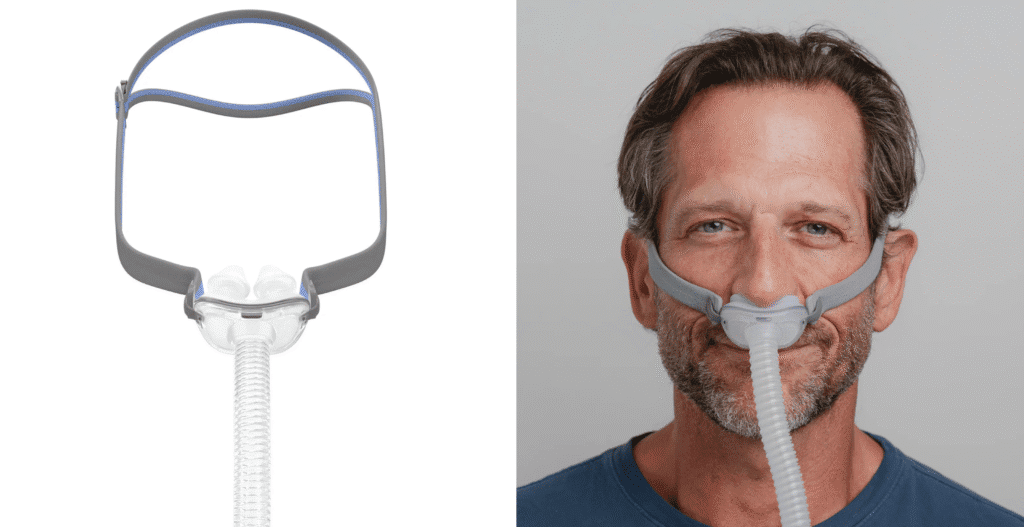
The ultra-lightweight AirFit P10 weighs just 4 ounces complete with headgear and uses a revolutionary 17-inch flexi-tube that moves with you instead of fighting against position changes.
The nasal pillows sit gently at your nostril openings without pressing on your nose bridge or cheeks, making it virtually unnoticeable during side sleeping.
At approximately 50% lighter and quieter than the previous model, it delivers proven performance at an accessible price point.
Note:
- Recommended pressure levels are 4-20 cm H2O, making it best suited for lower to medium pressure needs.
- Not compatible with the ResMed AirMini™ Portable CPAP device
2. Best Balanced Nasal Option: ResMed AirFit N30i Nasal Cradle Mask
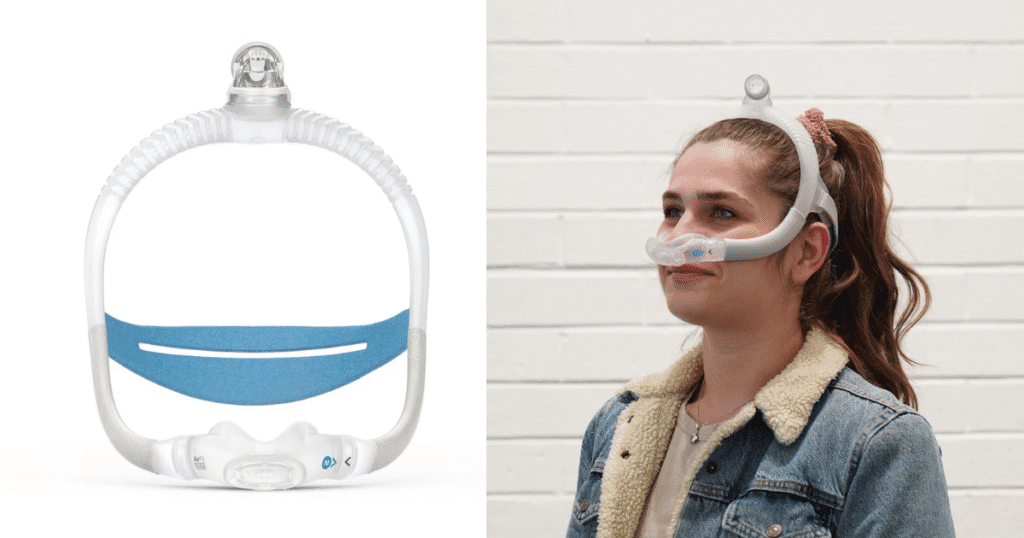
The AirFit N30i combines top-of-head tubing with a minimal-contact nasal cradle cushion that curves gently below your nose to help eliminate nasal bridge pressure that causes red marks and discomfort.
The flexible frame adapts to your movements throughout the night, maintaining seal integrity as you shift between sleeping positions. With four cushion sizes and fabric-wrapped contact points, it offers an excellent balance between comfort and coverage.
Note that some users experience slight warmth buildup compared to nasal pillows.
3. Best for Active Side Sleepers: ResMed AirFit P30i Nasal Pillow Mask
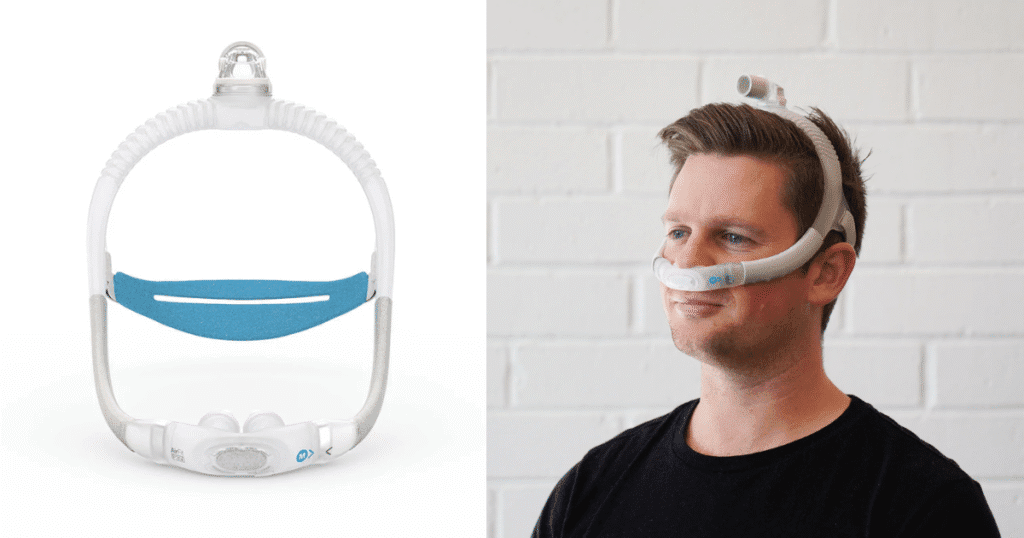
The AirFit P30i revolutionizes side sleeping with its top-of-head tube design that keeps tubing completely out of your way.
At just 3.2 ounces, this nasal pillow mask features a flexible frame that adapts to your movements while maintaining a secure seal—even when tossing and turning. The dual-wall nasal pillows provide soft comfort with supportive stability, and at 21 decibels, it’s whisper-quiet for you and your partner.
Note that mouth breathers may need a chin strap for optimal performance.
4. Best Full-Face for Side Sleepers: ResMed AirFit F30i Full Face CPAP Mask
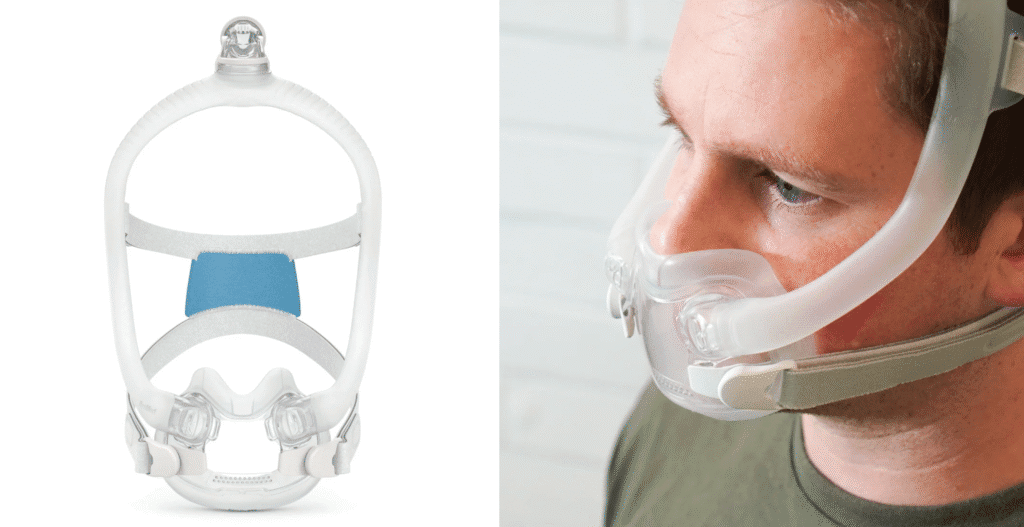
The AirFit F30i redefines full-face comfort for side sleepers with its under-nose cushion design that eliminates nasal bridge pressure.
At just 1.58 oz, it’s incredibly lightweight with a top-of-head tube connection that provides complete freedom of movement. The magnetic headgear clips make it easy to put on and remove even in darkness, while the flexible frame distributes airflow evenly without bulk.
Perfect for mouth breathers and those with nasal congestion, it handles pressures up to 30 cm H₂O.
Note: Contains magnets—check compatibility if you have implanted medical devices.
5. Best Compact Full-Face Option: ResMed AirFit F40 Full Face Mask
New Release
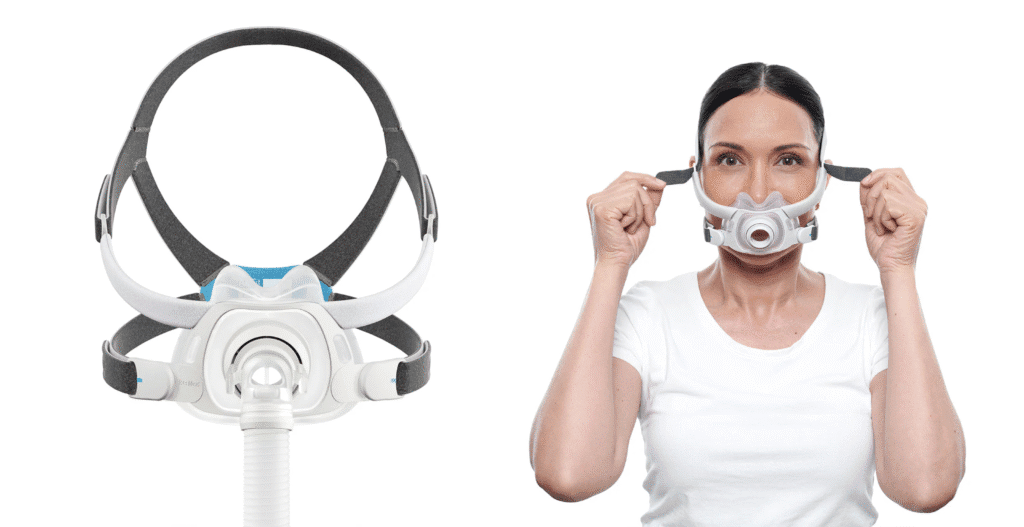
The AirFit F40 represents ResMed’s latest innovation in a compact full-face design.
As one of the smallest tube-down full-face masks available, it features AdaptiSeal cushion technology that dynamically adapts to your facial contours—maintaining seal integrity even during side sleeping position changes.
With a 98% fit rate across three cushion and headgear sizes, it handles higher pressures reliably while operating at a quiet 20 dBA. The triple-position adjustable elbow and flexible frame minimize pressure points.
Note: Contains magnets. Verify compatibility with medical implants before use.
6. Best for Sensitive Skin: ResMed AirTouch N30i Nasal Cradle Mask
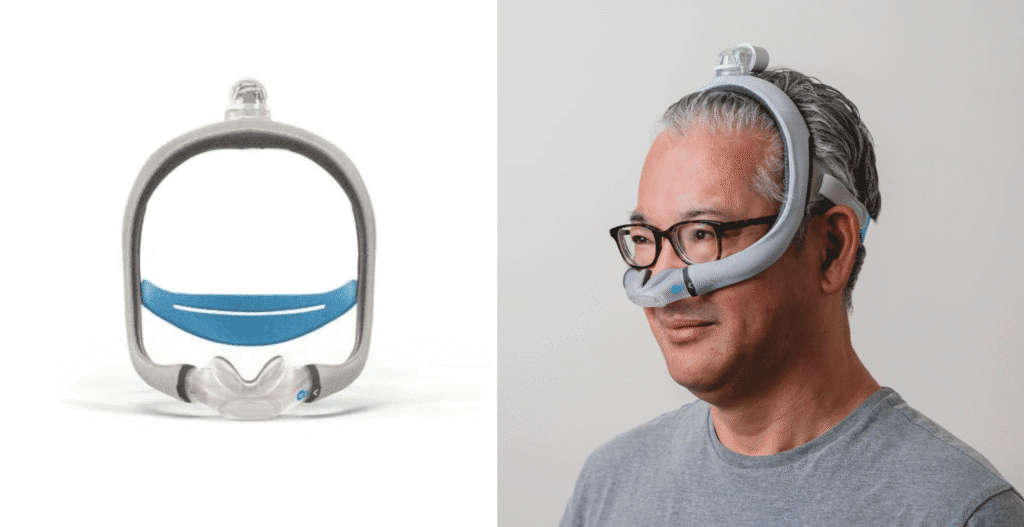
The AirTouch N30i takes the proven N30i design and upgrades it with a revolutionary ComfiSoft memory foam cushion that molds to your unique facial contours.
This breathable, silicone-coated fabric cushion wicks away moisture while the fabric-wrapped frame creates an ultra-soft feel against your skin—ideal for users who experience irritation from traditional silicone.
The memory foam adapts as you move, reducing pressure points during side sleeping.
How to Choose the Right ResMed Mask for Side Sleeping
1. Match Your Breathing Pattern
If you’re primarily a nasal breather, the P30i and P10 delivers ultra-light nasal pillows that let you switch positions freely, while the N30i and AirTouch N30i balances pillow-style comfort with a top-of-head tube connection for added stability.
For mouth breathers or anyone prone to nasal congestion, the F30i and F40 full-face masks keeps therapy running smoothly even when your breathing shifts.
2. Align with Your Prescribed Pressure
- Lower pressures (4-10 cm H₂O): All six masks perform excellently
- Medium pressures (10-20 cm H₂O): N30i, AirTouch N30i, P30i, F30i, and F40 offer more stable frames
- Higher pressures (20+ cm H₂O): F30i (up to 30 cm H₂O) and F40 provide the most reliable seal
Note: The P10 is limited to 20 cm H₂O maximum.
3. Fit Your Facial Features
- Narrow face: The P10’s slender nasal pillows naturally adapt to tighter facial contours, ensuring consistent seal integrity.
- Sensitive skin: AirTouch N30i with memory foam cushion.
- Facial hair: F30i or F40 memory-foam or silicone cushions conform around beards and mustaches.
- High nasal bridge: F30i or F40 under-nose cushions avoid painful bridge pressure.
4. Prepare for Night-Time Movement
A better fit for side sleepers who frequently change positions is the N30i, AirTouch N30i, P30i, or F30i top-tube designs, which prevent tangles and tugging when you roll.
If you’re a stable side sleeper, the minimalist P10 goes virtually unnoticed and is ultra-comfortable.
For very active sleepers, any top-tube connection CPAP mask keeps the hose out of the way so therapy isn’t interrupted, no matter how much you move.
By keeping note of how you breathe, the pressures your doctor prescribed, your unique facial shape, and your typical sleep movements, you’ll identify the ResMed mask that delivers both therapy effectiveness and all-night comfort.
5. Budget Considerations
- Most affordable: P10 offers proven performance at the lowest price point
- Mid-range: N30i, P30i, F30i, F40 provide advanced features
- Premium comfort: AirTouch N30i offers ultimate softness but with higher replacement costs
Side Sleeping CPAP Optimization Tips
After selecting your ResMed mask, use these practical strategies to help with a comfortable night sleeping on your side:
Use CPAP-Specific Pillows
Specialized CPAP pillows with mask accommodation cutouts dramatically reduce pressure points and prevent mask displacement. These pillows position your head optimally while creating space for mask components and tubing.
Perform Side-Position Adjustments
Always make final mask adjustments while actually lying on your side. This practice ensures proper seal in your actual sleeping position rather than the seated position used during initial fitting.
Install a Hose Management System
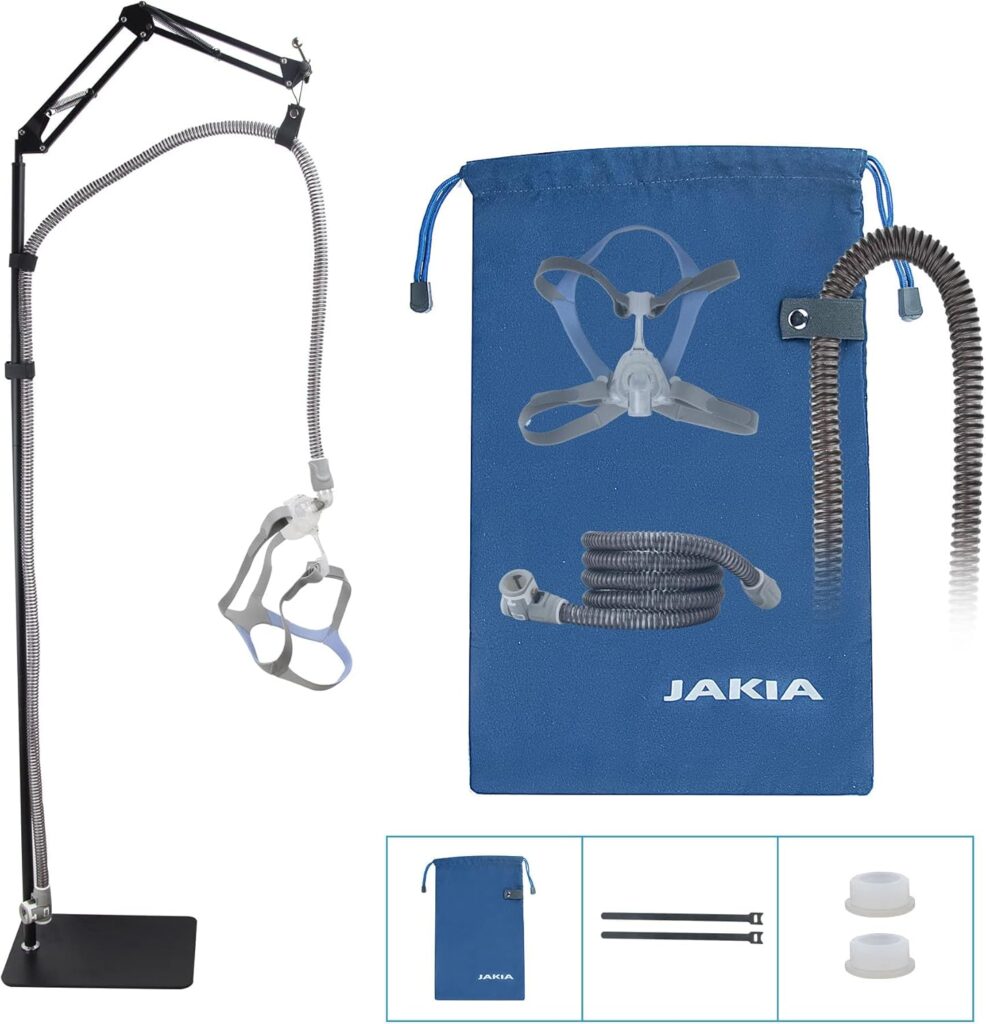
Shop Jakia Hose Tube Holder on Amazon
Suspending your CPAP tubing above your bed with a simple hose holder significantly reduces tugging on your mask as you change positions during sleep. See our other recommended CPAP hose holders in this article.
Maintain Proper Cleaning Routine
Clean your mask daily by wiping cushions with CPAP-safe wipes and perform weekly deep cleaning with mild soap and water. This maintenance ensures optimal seal performance and extends component lifespan.
Avoid Over-Tightening Headgear
A common mistake is cranking down headgear straps in an attempt to prevent leaks. This actually creates pressure points and paradoxically worsens leakage. Aim for the minimum tension required for seal integrity.
Understanding ResMed’s Side Sleeping Technologies
ResMed includes several features designed to make side sleeping easier:
- InfinitySeal™ Cushion: Adapts to movement while maintaining seal integrity
- QuietAir™ Venting: Diffuses exhaled air quietly to prevent partner disturbance
- SpringFit™ Frame: Automatically adjusts to maintain fit during position changes
- UltraSoft™ Memory Foam: Conforms to facial contours even when compressed against pillows
- QuickFit™ Elastic Headgear: Provides stability without requiring frequent adjustments
Understanding these technologies helps you identify which features best address your specific side sleeping challenges.
Proper Mask Maintenance for Side Sleepers
Side sleepers often experience accelerated wear on mask components due to increased friction against bedding. Follow these maintenance guidelines to extend longevity:
- Daily: Wipe cushions with CPAP wipes to remove facial oils and skin cells
- Weekly: Hand wash mask components in warm soapy water using fragrance-free soap
- Monthly: Inspect all components for wear, especially cushions and headgear
- Replacement Schedule: Replace cushions every 1-3 months and complete masks every 6-12 months
Regular maintenance ensures continued therapy effectiveness and extends the functional life of your equipment.
Frequency Asked Questions
What are the best CPAP masks for side sleepers?
Side sleepers benefit most from nasal pillow masks like the ResMed AirFit P10 or nasal cradle masks like the AirFit N30i. These designs offer minimal facial contact and flexible tubing that adapts to movement. Top-of-head tube connections are ideal as they keep tubing out of the way during position changes.
Why does my CPAP mask leak during side sleeping?
Side sleeping can create pressure points and shift your mask position, causing air leaks around the seal. Your facial structure changes when lying on your side, and gravity affects how the mask sits. Choosing a mask designed for side sleepers with minimal contact points can significantly reduce leaks.
How do you choose a CPAP mask for side sleeping?
Consider masks with minimal face contact, flexible frames, and strategic tube positioning. The ResMed AirFit P10 nasal pillows and N30i nasal cradle are excellent choices for active side sleepers. Full face options like the F30i work well for mouth breathers who sleep on their side.
How often should I replace my ResMed mask cushion as a side sleeper?
Side sleepers often need more frequent replacement due to increased compression against pillows. Replace cushions every 1-2 months rather than the standard 3-month interval recommended for back sleepers.
What causes facial marks from my CPAP mask?
Facial marks result from excess pressure, improper size, or material reactivity. Try looser headgear settings, different cushion materials, or mask liners to reduce morning marks.
Are nasal pillows effective at higher pressure settings for side sleepers?
Nasal pillows can work at higher pressures for some users, but many side sleepers find nasal cradle designs like the N30i provide better stability at pressures above 15 cm H2O.
Key Takeaways for Side Sleepers Using ResMed CPAP Masks
ResMed offers several mask designs specifically engineered to address side sleeping challenges. The most effective mask for you depends on your unique breathing patterns, facial structure, pressure requirements, and comfort preferences.
Investing time in finding the right mask significantly improves therapy adherence, comfort, and sleep quality. With proper selection, adjustment, and maintenance, side sleeping with your ResMed CPAP mask can provide the restful, therapeutic sleep you need.
Related Reading
- Smallest CPAP Machines For Travel
- CPAP Cleaning Machine for Resmed Airsense 10
- BiPAP vs CPAP Understanding the Differences in Sleep Apnea Therapy
- Sleep Apnea Mouth Guard vs CPAP
Important Disclaimer: Always consult with your sleep specialist or CPAP provider before making significant changes to your sleep therapy equipment or routine. This article provides general information and is not intended as medical advice.
